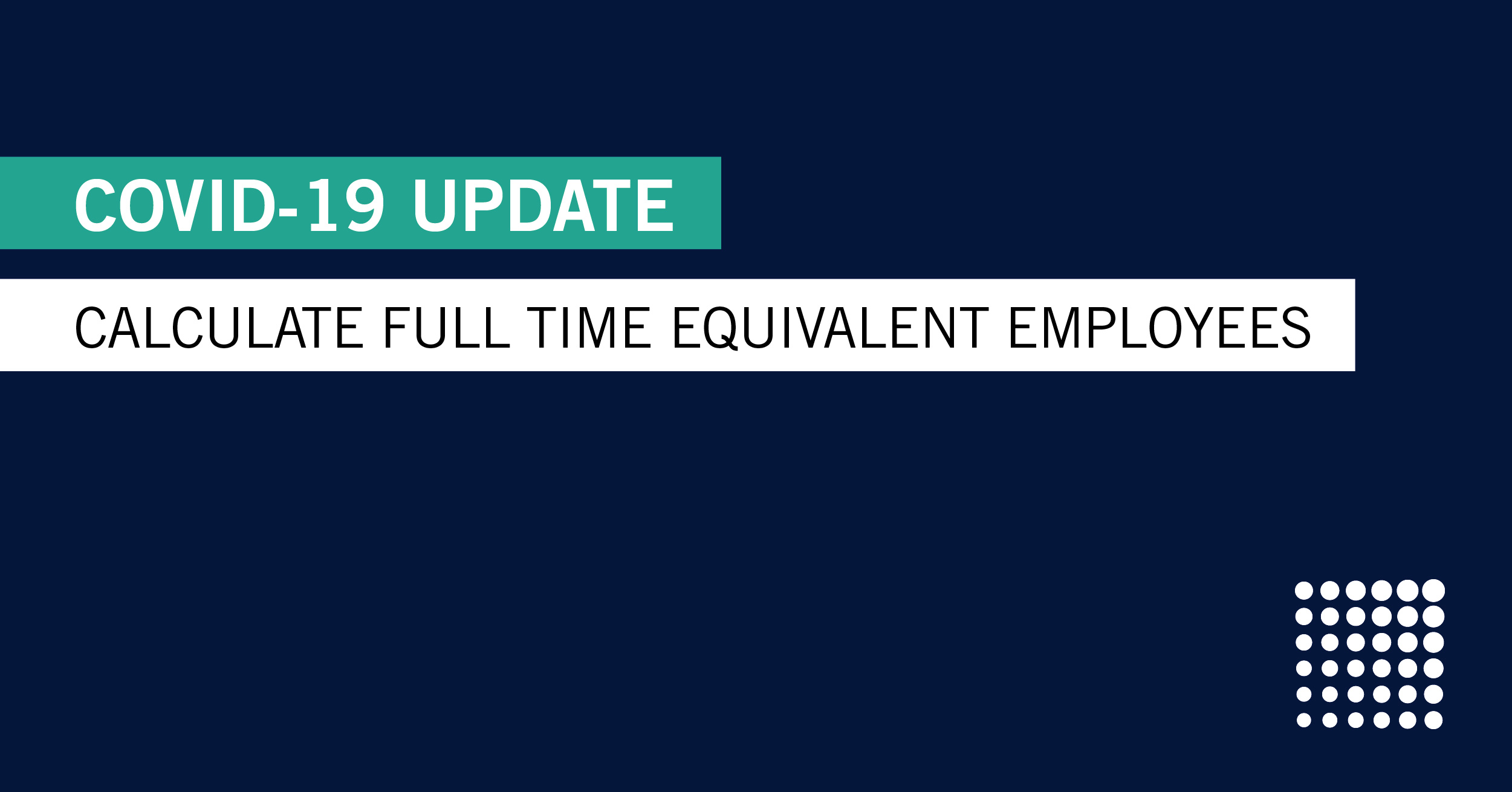Advantages To This Alternative For Business Owners
“How do I maximize the forgiveness of the PPP loan?”
Well, that is the $659 billion-dollar question for borrowers of a Paycheck Protection Program (PPP) loan. As noted in our recent blog post about the alternative payroll covered period, it seems as though the SBA is adding some flexibility for employers seeking loan forgiveness on the PPP loan.
While we patiently wait for guidance to clear up remaining questions related to forgiveness of this loan, we did get some clarity on what constitutes a full-time equivalent employee (FTE) under the program from the 11-page forgiveness application.
As noted in the CARES Act, employers have a requirement to employ the same number of full-time equivalent employees during their 8-week covered period (or alternative payroll covered period), as were employed during one of two look-back periods.
At the borrower’s discretion, the look back periods can be either Feb. 15–June 30, 2019, OR Jan. 1–Feb. 29, 2020. The CARES Act went further to state your total forgiveness may be reduced by a proportional percentage of employees not rehired during the covered period as compared to your look back period.
Lastly, the act provided a “safe harbor provision” which eliminated this reduction, as long as you rehired all of your staff at their normal pay rate by June 30.
HOW TO CALCULATE YOUR FTE EMPLOYEES
The new loan forgiveness application is complicated and leaves borrowers with many unanswered questions; however, it did provide clarity on how borrowers will need to calculate the number of full-time equivalent employees.
The application tells us that 1.0 FTE employee is an employee who works 40 hours (or more) during the work week. If the employee is working less than 40 hours, they are a fractional portion of a FTE, to be rounded to the nearest tenth of a point.
For example, an employee working 32 hours per week would count as a 0.8 FTE employee under the bill. This calculation should be reported as the weekly average through your covered 8-week period (or alternative payroll covered period), as well as the look back period of choice.
SIMPLIFIED CALCULATION METHOD
It seems as though the SBA has recognized the complexities brought upon sectors of the economy, as they have added flexibility for employers who have obtained a PPP loan.
Particularly, the loan forgiveness application has a simplified method of calculating FTEs. This method allows employers to assign a 1.0 for each employee that works 40 hours (or more) per week, and 0.5 for any employees that work less than 40 hours per week.
If we use the same example as above, the employee working 32 hours per week would count as a 0.5 FTE under the simplified method. What is crucial here, is if you do not have the patient flow to be open your normal 32 hours during your covered period, then you should still be able to assign a 0.5 to that employee, even if they are now only working 16 hours per week as you ramp up your practice.
FTE REDUCTION EXCEPTIONS
One of the issues that employers have been fearing is their employees choosing not to return, and the effect that will have on their PPP loan forgiveness. This application gave some relief as it relates to bringing your staff back and some chose not to accept their original position or certain business decisions were made as it relates to staffing.
Your reduction in FTEs will not be impacted if the business owner made a good-faith written offer to rehire an employee and the employee rejected the offer. This must be documented by the business owner. We recommend using the CEDR HR Solutions rehire letter and having the employee sign the document noting they are turning down the offer.
Additionally, this reduction rule applies to any employees that were fired for cause, voluntarily resigned or voluntarily requested and received a reduction in hours.
STRATEGY IN FIGURING YOUR FTE’s
Staffing challenges have understandably created concerns relating to the amount of PPP loan forgiveness reduction borrowers might face under the original calculation previously provided.
Most practices will benefit from the utilization of the simplified calculation method opposed to the more detailed calculation. Thus, this allows you to bring employees back into your practice as they are needed, not out of an attempt or obligation to have your PPP loan forgiven.
If there is a concern for how your practice will bounce back and you are concerned you will not be able to bring back the same number of employees, consider bringing staff back on slowly and filling their hours to capacity before bringing on the next staff member.
We have outlined how this works in the following examples.
Example 1:
A practice had 7 employees on payroll when looking back at the time period from Jan. 1– Feb. 29, 2020. Of these 7 employees, 1 works a full 40 hours and the other 6 work 32. The employee working over 40 hours would equal 1 FTE while the other 6 employees would each count as a .5 FTE for an equivalent of 3 FTEs. In total, the practice would report 4 FTEs when considering the look back period.
Upon the practice reopening, it was decided that the one 40-hour employee would continue to work their 40 hours, still counting as 1 FTE. Of the 6 remaining employees, 5 would resume their normal 32 hour per week jobs counting for 2.5 FTEs.
The last remaining employee has been brought back on with increased hours to help with new practicing measures and patient back up and will be working 40 hours per week, equating to another 1 FTE. This totals 4.5 FTEs under the simplified method, thus resulting in no decrease when comparing back to the previous time period.
Example 2:
The same fact pattern would apply for the look back calculation but upon returning to the office, you now have reluctance from the staff or a decreased need for staff in the practice.
You now have your 1 employee still maintaining 40 hours per week, equaling 1 FTE. Of the remaining 6 employees, 4 of them have agreed to work back between 16 to 24 hours per week, thus each count as a .5 FTE, equating to 2 FTEs.
The other 2 employees have decided to not accept their employment offer to come back. The total FTEs to report would be 3 FTEs, but due to the exceptions provided above, the 2 employees that did not accept their positions will not count against your FTE calculation, thus no reduction in loan forgiveness would apply.
As we have pointed out in recent posts, Congress has suggested they are considering extending the 8-week period to something longer. This not only allows for a longer covered period to expense funds, but also allows for more time to have your practice operating closer to full capacity, thus allowing borrowers to bring back all FTEs in a manner that is prudent to control overhead.
Our advisors can help you sort through the uncertainty. Learn more about our services:














